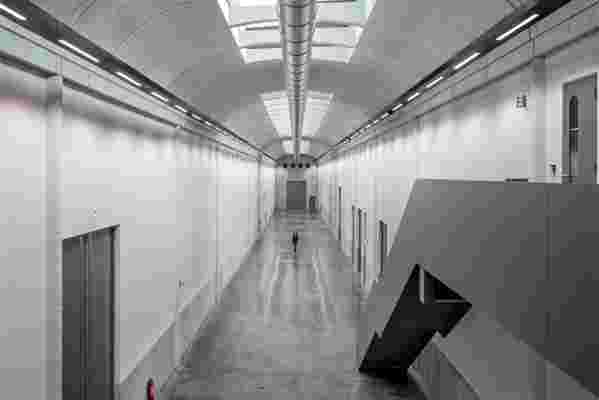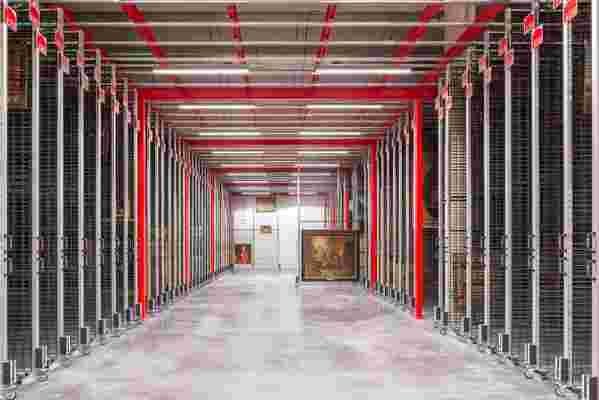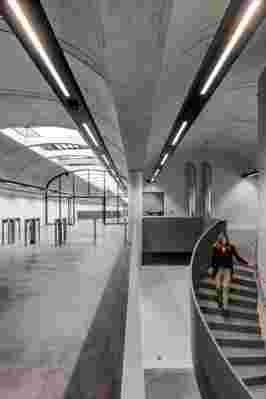September 12,2022
Fearing Climate Change, the Louvre’s New Conservation Center Will Hold One-Third of the Museum’s Entire Art Collection
by David Stewart
In 1910, there was the Great Flood of Paris: Excess rainwater raised water levels eightfold. Photos from that time show locals riding down streets in makeshift boats . With global warming, there is a 40% increase in the chance of a similar flood happening nowadays. So if that does happen, in a city chock-full with culture, what will happen to the art?
The Musée du Louvre in Paris is home to one of the most valuable art collections in the world, including famed artworks like the Mona Lisa and The Winged Victory of Samothrace. With it comes a great risk of water damage. The museum has created a new venue to store its valuable art—the Louvre Conservation Center in Liévin, in the north of France.
This $120 million project, which opened in October, was designed by British architectural firm Rogers Stirk Harbour + Partners. Over the past few months, 141 semi trailers have been driving more than 100,000 artworks from the museum to the new center (it will house over 250,000 art objects).

The building will eventually hold one-third of the Louvre's entire collection.
“First and foremost, it is our duty to preserve this heritage for future generations,” Jean-Luc Martinez, director of the Louvre, said in a statement. “The DNA of the museum, its beating heart, is the art.” The works stored underground at the museum are vulnerable to flooding that tends to happen every decade. Let’s not forget the flood of 2016, which saw high floods for the first time in decades . And while some say that art can’t survive climate change , this new center suggests that indeed, it could.
They’re storing some of their most valuable pieces—like the Venus de Milo —in the warehouse in case the river Seine in Paris overflows . And the museum will continue to transport the art during the pandemic, according to Néguine Mathieux, the director of research and collections. “We are happy to have been able to pursue these transfers, to protect as many artworks as possible from the risk of flooding of the river Seine,” Mathieux tells AD . “By mid-2021, all the objects at risk will be transferred to the conservation center.”
While only 36,000 artworks are on view at a time at the Louvre, its collection boasts over 620,000 pieces, so this new center will be home to one-third of its entire holdings. The new center has six storage areas, including dry, low-humidity areas for metalworks, a photography studio, workshop rooms, a varnishing booth, and study space. The center has large windows for natural light, and the rooftop garden features 27 seed varieties. More than 5,000 plants have been sown around the building.

Officials plan to have all of the objects at risk to be transferred to the conservation center by mid-2021.
“The use of simple, elegant forms creates a powerful language of great French fortresses that retrains a large, inclined park, which protects the works of art below,” said Graham Stirk, a senior design partner with RSHP. The center has a team of 15 who are managing the artworks, maintenance and safety of the building, and administrative affairs. Since opening last fall, the pieces that have been shipped over include Roman and Etruscan antiques, as well as those from Egypt and Greece.
The museum won’t be moving some of the most delicate archaeological findings (which are in fragments), or some of the drawings, prints, and manuscripts that are too fragile to be exposed to light (they’re in the museum’s Cabinet des Dessins, in a safe area protected from flooding).
Even though the museum has a flood-risk prevention plan, that doesn’t mean there wouldn’t be enough time to protect all the artworks. The museum is hoping the location will become one of Europe’s largest art research centers, sprawling over two acres of indoor space, as it’s more than just a storage space but a research facility for museum experts, conservators, and academics.

Similar art conservation centers have been built for museums in London and Amsterdam.
The Louvre’s art collection is kept in 68 different sites both in and out of the museum. “All of this helps us get to know the collections we are entrusted with better,” said Martinez. “It’s going to be a hive of activity,” he adds. “It’s the biggest move in the entire history of the Louvre, and perhaps that of museums everywhere.”
Other museums are catching on: The British Museum is currently building storage spaces in Shenfield, just 50 miles from London, while the Rijksmuseum is helping develop the Netherlands Collection Centre in Amersfoort, 30 miles from Amsterdam.
From the outside, the conservation center looks like a Bauhaus-era bunker, yet the entranceway calls to mind an underground metro. Everything is very concrete and clean, to keep artworks protected from a flood. “The building is sited on well-draining subsoil; chalky sand over a layer of chalk bedrock,” says John McElgunn, RSHP’s project partner. “Everything is sized to deal with rainfall well in excess of the current historical records and future rainfall projections for the area.”
An aerial view of the new building shows the rooftop garden, which features 27 seed varieties.
This building is double-waterproofed. “The upper layer is equipped with a leak detection system from Progeo in Germany, which can pinpoint the location of any leak over the surface of the roof for immediate and straightforward repairs,” says McElgunn.
It looks like an elliptical hill in the heart of a green parkland. “We placed it under a continuous landscape to create a free height that the Louvre required to house large and small artifacts,” says McElgunn.
This incognito center takes its cues from military bunkers, indeed. McElgunn says the exterior walls are reminiscent of design by French military engineer Sébastien Le Prestre de Vauban. “They make a powerful statement,” he explains. “The building is a modern-day fortress, protecting the art within using both the landscape and state-of-the-art conservation technology.”






